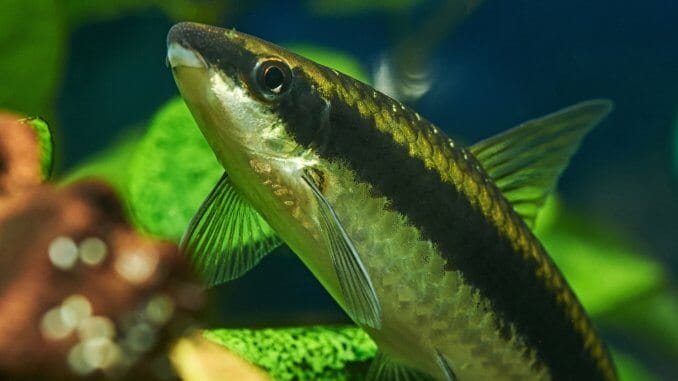
When looking for fish to add to your tank, you can sometimes get lost in the number of freshwater varieties there are, but other times you’re looking for a fish to fill a particular role.
Siamese algae eaters fill a particular role, they’re perfect for someone looking for a fish that will help to tidy up their tank by clearing algae.
They’re active and social creatures that will do well in both large groups, and when kept alone. At feeding time they’re easy and will eat anything put in their tank.
Because they’re peaceful, these fish are ideal for beginners to add to their community aquarium. One thing to look out for is the Siamese flying fox which looks almost identical to the algae eaters and as a result, they are often confused.
TABLE OF CONTENTS
Siamese Algae Eater Facts & Overview
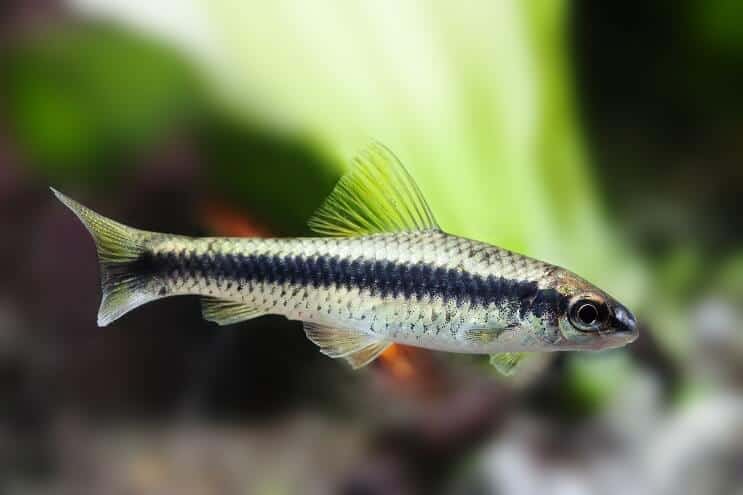
| Category | Rating |
| Care Level: | Easy |
| Temperament: | Peaceful |
| Color: | Gold/Grey with Black Stripe |
| Lifespan: | Up to 10 years |
| Size: | 6 inches |
| Diet: | Omnivore |
| Family: | Cyprinidae |
| Minimum Tank Size: | 20 gallons |
| Tank Set-Up: | Freshwater, Heavily Planted |
| Compatibility: | Peaceful Community Fish |
Siamese algae eaters, or Crossocheilus oblongus, are freshwater fish from the Cyprinidae family. This family contains carp too, which are closely related.
They originated from Southeast Asia, including Thailand and Malaysia, but now they’re bred across the world for the aquarium trade. The reason they’ve become so popular is that they’re one of the best algae eaters available. They move around a lot, so they cover the whole tank quickly.
While the movement helps with the algae, it keeps your tank active and interesting too. Lots of other algae eaters don’t move much (like nerite snails).
Most pet stores sell them because of their popularity, so they’re easy to find. They’re cheap too, at around $3-$5 per fish.
These fish are great for beginners, they make the job of keeping the tank clean much easier and their behavior is unlikely to be an issue. That being said, Siamese algae eaters produce waste just like any other fish. Overstocking can make your tank messier rather than cleaner.
Typical Behavior
Most of their time is spent in the bottom levels of the tank. Here they swim around until they find a spot covered in algae, they’ll likely sit here until it’s gone.
If you keep a few together they’ll form groups and you’ll find them feeding together in the same area.
They’re rarely aggressive, but they’re quite energetic and swim around quickly. This means that they shouldn’t attack other fish but might disturb and unsettle any calmer species.
If they are aggressive then watch them closely for a couple of days, they might have to be separated if the problem persists.
Appearance
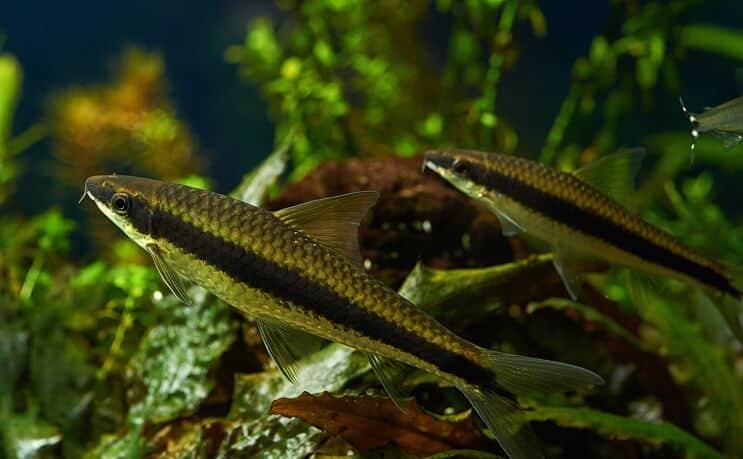 True Siamese algae eaters have a long, narrow body that reaches up to six inches. They’re usually a pale grey or gold with a black stripe that spans from the head to the tail.
True Siamese algae eaters have a long, narrow body that reaches up to six inches. They’re usually a pale grey or gold with a black stripe that spans from the head to the tail.
You might find that the stripe begins to fade; this could be during a mating display, times of stress, or a way to camouflage themselves (which is less common in the aquarium).
There are no differences between males and females until around 3-4 years old, and at this point the only thing that gives away their sex is size. Females are around 30% larger in mass than males.
Siamese Algae Eater vs Flying Fox
The Siamese flying fox (Epalzeorhynchos kalopterus) often gets mistaken for the algae eater because they look so similar. They both have a bold, black stripe running down their body.
The easiest way to work out which species you are looking at is to check for flaps in the corner of the mouth. Flying foxes have them but algae eaters don’t. However, this is nearly impossible to check when the fish are alive and swimming around, so you can make an educated guess by looking at the color.
The black stripe on the flying fox tends to be smoother and it ends where the tail fin begins. The algae eaters are less uniform and stretch to the end of the tail fin.
Habitat and Tank Conditions
In the wild, you will find Siamese algae eaters in the densely planted rivers and streams of Southeast Asia. These are the same habitat preferences of closely related Asian Carp.
These tropical waters are slightly acidic and don’t tend to have a fast current. Under the surface, you will find lots of plants, rocks, and logs that provide shelter.
An algae eater’s time is split between hiding in these shelters and searching surfaces for foods. This is mainly algae, but also other things that sink to the bottom of the river.
They’re not the best explorers, they tend to stay around shelters they’re familiar with and rarely venture up to the surface of the water.
Their ideal home setup is a recreation of this natural habitat.
Tank Conditions
As they spend most of their time near the bottom of the tank, a sandy substrate makes it safer for them to swim around without scratching their body or damaging their sensitive barbels.
Plants should be added to make them feel at home. They act as shelter while keeping the water cleaner and oxygenated.
There’s a chance that your fish will start nibbling at some of the plants if they can’t find any other food. Keeping them well fed is the best way to protect your plants. One strategy is to use fast-growing species, like hornwort, that can quickly recover if any parts get eaten.
All fish like to have somewhere they can hide away from their tank mates, bottom-dwelling fish especially. Create caves around the tank to give them an escape. They aren’t territorial so there shouldn’t be any squabbling over who goes where.
Most fish can jump, but some can do it better than others. Siamese algae eaters are active and quick which makes it easier for them to jump from the water. Keeping a lid on the tank makes sure that you don’t come home to a fatal escape attempt.
You’ll need a heater to keep the water within a range of 75-79°F. Water hardness should be 5-20 dH.
Ideally, the pH would be between 6.5 and 7.0, but they can tolerate a slightly wider span if necessary (roughly 6.0-8.0).
They don’t have any special water flow requirements, which might be surprising since they naturally live in rivers. These would be slow-moving and the current would be even weaker at the river bed where they live.
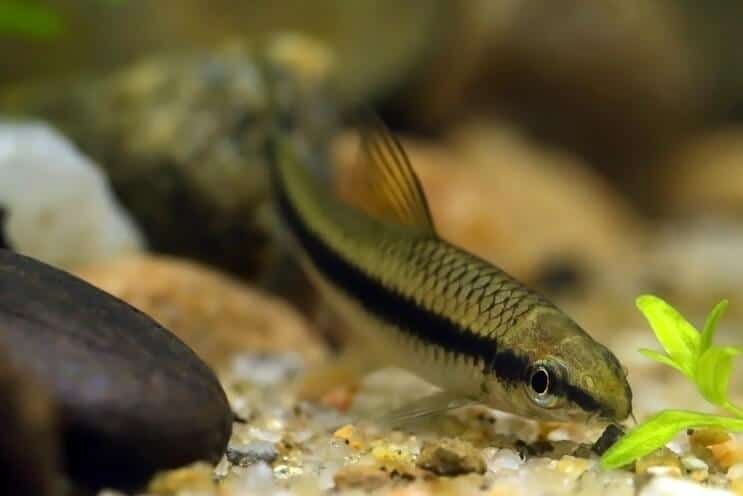
What Size Aquarium Do Siamese Algae Eaters Need?
They will need at least a 20-gallon tank.
How Many Siamese Algae Eaters Can Be Kept Per Gallon?
You will need 20 gallons for the first fish and an extra 10 gallons per fish added after this.
Tank Mates
Siamese algae eaters are peaceful creatures which means there’s a long list of potential tank mates. This makes them good candidates for a community aquarium.
Since these fish spend their time at the bottom of the tank, you need to think about what else will be living there too. Lots of bottom-dwellers can be territorial or just bully those that get in their way. Red tail sharks are a good example; they harass others to protect their territory when they mature. This isn’t a battle your peaceful algae eaters would win.
There are plenty of peaceful bottom-dwellers for you to choose from. Corydoras are some of the most popular; this genus contains lots of different species.
Fish that live in other areas of the tank won’t have any territory disputes so there’s an even wider selection. Don’t add any notoriously aggressive fish because they might attack or eat your algae eaters.
This usually means avoiding cichlids, many of which should only be kept in a species-only tank anyway. There are some peaceful exceptions though, like angelfish.
Tetras, danios, and guppies work well because they’re small and not aggressive. You can also use bigger fish like gouramis and barbs because their size doesn’t come with added aggression.
It’s good to remember that your tank mates don’t have to be fish. Other animals can be added, most of which tend to eat algae too. The most common are shrimp (amano, cherry, and ghost) and snails (like nerite snails).
Mixing in shrimp and snails with your fish shows off some different behaviors, adding extra interest to your tank. They still contribute to the biological load of the tank though so don’t overstock your aquarium.
Keeping Siamese Algae Eaters Together
You can keep more than one Siamese algae eater in the tank. They show off their best behaviors in schools of at least 4-6.
This doesn’t mean that you need to keep them in a school though, they do well when kept singly or in pairs too.
Diet
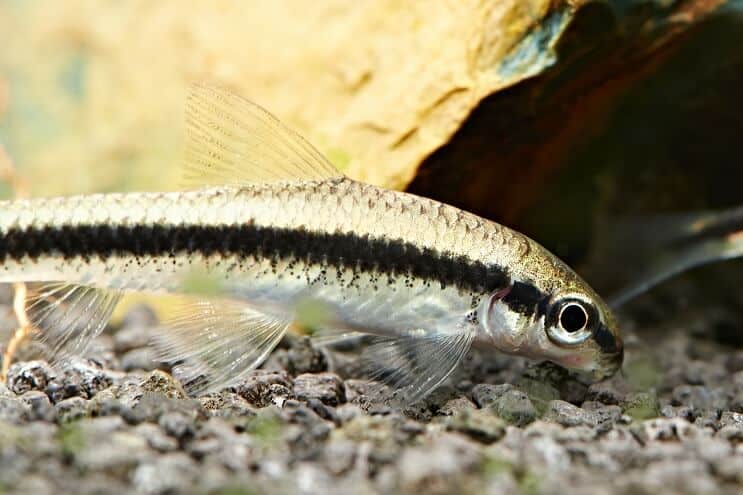
The main part of their diet is in their name. In the wild they would eat algae, plant matter, and vegetation but they’re not just herbivores. They’re scavengers so they will eat whatever they find, including dead fish and insects.
It’s easy to provide for them in the aquarium, they are not fussy and will eat most things you add to the tank. This includes flake and pellet foods from stores, algae wafers and live foods. Good examples of live foods are brine shrimp and bloodworms, frozen varieties will work well too.
Sinking foods like pellets are good for bottom-dwelling fish as they’re more likely to fall past fish higher up in the tank.
Overfeeding can be a problem because they already have some algae and plants in the tank before feeding time. Sometimes Siamese algae eaters will stop eating algae in favor of the other foods you give them if you keep adding too much.
They can eat a lot, they would eat all day if you let them. Limit feeding to an amount that they can easily finish in a couple of minutes each day.
Care
There aren’t any specific diseases that these species are prone to, but that doesn’t mean they won’t get ill at some point.
Most diseases give off signs, some are more obvious than others. For example, the common Ichthyophthirius multifiliis parasite (generally known as “ich”) causes small white dots around the body.
Lots of diseases have treatments and medicines that you can buy which work well with quarantine tanks, but there are ways to help prevent your siamese algae eater getting diseases in the first place.
- High-quality foods are less likely to cause organ problems. Cheaper foods can cause constipation which often leads to further effects.
- Dirty water is like humans breathing polluted air, so water changes should be done every two weeks to reduce the buildup of pollutants.
- Be careful what you add to your tank. Decorations can carry toxins, and water from other aquariums might bring diseases.
Breeding
It’s unlikely that you’ll be able to breed these fish yourself, even though they mate in the same way as lots of other fish. They’re only known to breed in farms with the aid of hormones.
Simply sexing them is hard enough and needs a keen eye. Females are about 30% larger once fully matured.
Spawning could probably be triggered by changes in water conditions (temperature, pH, etc.), but currently little is known about how to breed them in home aquariums.
Are Siamese Algae Eaters Suitable for Your Aquarium?
Whether you’re new to fishkeeping or you’ve been doing it for years, you shouldn’t have a problem keeping Siamese algae eaters happy and healthy.
They’re peaceful and hardy so less likely to fall victim to beginner mistakes.
If your tank contains plants, peaceful fish, and has enough free space, they will thrive.
In return, your aquarium will look cleaner and more lively.
Siamese Algae Eater FAQs
- How long do Siamese algae eaters live?
- What do Siamese algae eaters eat?
- Can Siamese algae eaters live with guppies?
- What is the difference between a flying fox and a Siamese algae eater?
- Are Siamese algae eaters fin nippers?
- How many Siamese algae eaters can I keep in a 20-gallon tank?
- Can betta fish live with Siamese algae eaters?
- How many Siamese algae eaters should I have?
- Do Siamese algae eaters eat algae?
- How big do Siamese algae eaters get?
- Can I keep one Siamese algae eater?
- Are Siamese algae eaters aggressive?

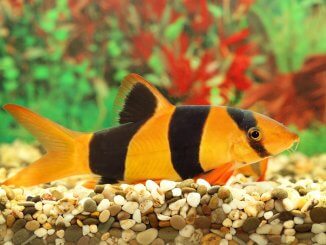
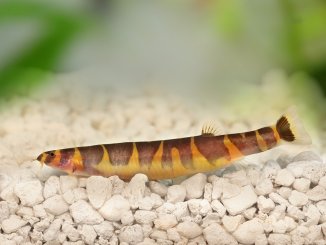
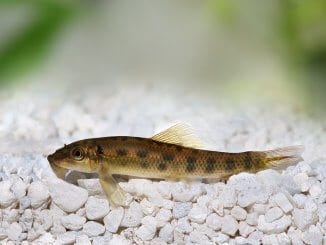
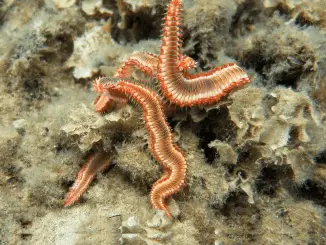
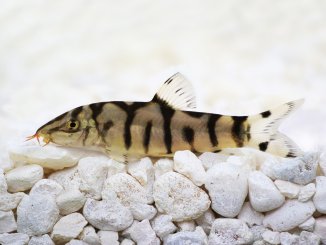
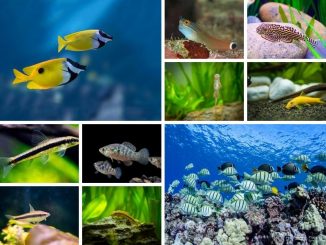
Does any algae eater attack or kill any other type of fish
They are omnivores so will eat both plant matter and meat, however they are peaceful so they’re unlikely to kill other fish. Thanks, Robert
Sometimes a Chinese algae eater does. I think. But I had one of those CAEs but it didn’t harm the fish.
This fish are amazing at cleaning up the tank. And I find them fun to watch work . Just watch out for the flying fox. Becouse they will eat you plants to .
We have a 9/10 year old algae eater who has been in an aquarium with bristlenosed catfish quite happily for all of this time. The other 3 algae eater companions have died over the years though, and we wonder if it would be best to add a few more now, or leave her on her own, as she is pretty old judging by what we have read.
Hi Steve, it’s totally up to you. How does she seem on her own? Is she as happy as she was before, or stressed? I’d judge it from that basis. Thanks, Robert
Hi I’ve an siamese algae eater, it always seems to stick itself to top of my tank is that normal?I’m a beginner to this so don’t know that much.
Hi Angela, do you mean it sticks itself to the lid of your tank? If so, I would make sure you’re leaving a gap with air between the water level and the lif of the tank. Thanks, Robert
I put 5 crossocheilus siamensis in my 4 foot tank and overnight they cleaned every plant leaving no algae anywhere. As I am now retired and living in Thailand I’m planning to try and catch some from the southern rivers. I am hoping to buy a 6 foot, by 2 foot deep, 18 inches wide tank in the next few weeks. We can get them made to order so should be no problem. Biggest problem here is keeping the water cool, opposite to the UK! I am hoping to adapt a drinking water cooler to do this.
Does anybody know if SAE will eat guppy fry?
Hi Greg, they are omnivorous so it’s very likely that they will eat guppy fry. Thanks, Robert
Hi, new tank owner here. I have a fairly mild-mannered betta that I was looking to get some tank mates for. Would two be okay to put in a 10gallon?
Hi Laken, unfortunately not. Siamese Algae Eaters need a minimum tank size of 20 gallons. Thanks, Robert
Hi I’m a new to aquarium fish care.
I’ve been feeding with pellets, worms and sinking wafer.
Is it ok if I don’t feed my 3 Siamese catfish with algae wafer
Su
Hi Su, I’m sure your catfish will be getting enough with the pellets worms and sinking wafers if there is plenty of plant growth and algae in the tank too. Thanks, Robert
SAE will eat anything and by that they can get very fat. Very fat. In my community tank they grab fish food dedicated to the carnivores in the tank along with herbivore food and algae being the last choice.
Hello, I read the comment above re the old algae eater and whether to add a ‘friend’. I am in a similar position.. I’ve had an algae eater since 2013 and she seems pretty happy and very peaceful towards other fish (corys and tetras) I’m worried she’s lonely because the others are in groups but my tank is quite small for a shoal of algae eaters (90cm x50cm x50cm) I’m also worried about adding a friend and having them fight.. how do I know if she’s stressed and is adding another a good idea? I’d be grateful for your expert opinion..thanks (I say she because she’s quite fat! 4.5inches long)
Hi Amy, you’ll notice is she is stressed if her behavoir changes in anyway, she loses color or starts eating less. If there are other fish in the tank, I’ll say she is most likely fine! Thanks, Robert
Hi, we’ve had our 120ltr tank running about 6 months now and have a pair of SAE’s. Didn’t know what sex they were although one is slightly bigger than the other so we could have a M/F. Just recently I’ve noticed the pair of them getting jiggy with it. Having read how hard it is to bread these, which in turn gives very little information is it unlikely she will spawn? If so what should I expect? And should I put her in a breeding tank? Do they eat there own or will she protect them or am I just wishful thinking? Many thanks.
Is a 15 gallon tank too small for a pair of SAE?
Hi Degus, yes this is too small. You’ll need a minimum 30 gallon tank for two SAE’s. Thanks, Robert
You’re completely right about tankmates. I had a Blue Acara and a Rainbow shark that would terrorize my SAE. I removed the shark and still the acara couldn’t tell the difference so I had to remove him as well. Now my SAE is out and about doing it’s happy thing.
What should I feed my SAE and how often. Also would a sailfin molly be an ok tankmate.
Feed a SAE at least 1 time a day and maybe 2 times is normal.
Hi. You said that the water hardness should be 5-20dH. Are you referring to the kH or the gH reading? I have never fully understood this topic. Using my Colombo test kit I’ve just had a kH reading of 2dH and a gH of 18.
My SAE in this tank is very pale in colour.
The SAE in my other tank is darker. Readings in this tank are; kH @ 6dH and gH @ 15dH.
Both tanks are around pH7.5.
Thanks
Eric
Can I keep a couple SAEs with Golden Zebra (or Burmese) loaches? They are very active. I have 3 of them, along with Rainbows and a few melon barbs in a 36 gallon. I’m mostly concerned about the loaches since they share the bottom.
Hi, I have 1 SAE in my 55 gallon tank but it is always very paranoid and would be darting to hide whenever I get close to the tank. is this behaviour normal?
It seems my sae are displaying breeding behavior. A little faded colour on both male and female(larger and big belly?) aswell as some “dancing”. Probably wont come anything from it due go the other fish in the tank but still fun?
And i will ofc. Keep an eye on the for incase it is actually fighting. ( they have lived together in this tank for about 1,5years now with 4more friends and never done anything similar before that i know of. ??
I have a SAE in a 30 gallon tank with a sorority of Mollies. They get along fine, and every so often s/he joins the group looking for food. I first got her because of a black algae problem, which is now gone. And s/he seems content with her tank mates.
I only have a nine gallon tank which I know is too small for SAE. However, apart from nerite snails (I have one), what else would be a good proxy for black hair algae good for my tank- it IS a heavy planter tank with only guppies? Thank you.
Can I have 2 Siamese with 5 clown loaches in a 55 gal. ? I also have 1 bristlenose, 8 barbs, 2 angel, 1 blue ram.
Hey new SAE owner I just got a pair. I saw that everyone above said that 2 need to be in a 30 gallon. What’s the reason for that? Is it for food reasons?
My SAE died after many many years. Throughout her life (big with deep belly) she was great at keeping the hair algae in check, but never harmed the many plants in my aquarium. I am now looking for a replacement but shops keep trying to fob me off with flying foxes. Very irritating as I’m fully aware of the differences, but others might not be so able to stand their ground. Thank you for publishing the differences in your article.